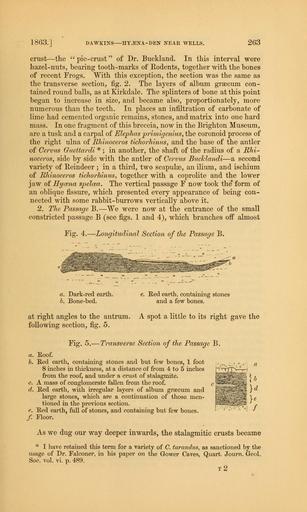MAKE A MEME
View Large Image

| View Original: | The_Quarterly_journal_of_the_Geological_Society_of_London_(12645887573).jpg (1225x2046) | |||
| Download: | Original | Medium | Small | Thumb |
| Courtesy of: | commons.wikimedia.org | More Like This | ||
| Keywords: The Quarterly journal of the Geological Society of London (12645887573).jpg 1863 DAWKINS HY2ENA-DEN NEAR WELLS 263 <br> crust the pie-crust of Dr Buckland In this interval were <br> hazel-nuts bearing tooth-marks of Bodents together with the bones <br> of recent Frogs With this exception the section was the same as <br> the transverse section fig 2 The layers of album graecum con- <br> tained round balls as at Kirkdale The splinters ot bone at this point <br> began to increase in size and became also proportionately more <br> numerous than the teeth In places an infiltration of carbonate of <br> lime had cemented organic remains stones and matrix into one hard <br> mass In one fragment of this breccia now in the Brighton Museum <br> are a tusk and a carpal of Elephas primigenius the coronoid process of <br> the right ulna of Rhinoceros tichorliinus and the base of the antler <br> of Cervus Guettardi ; in another the shaft of the radius of a Rhi- <br> noceros side by side with the antler of Cervus Bucklandi a second <br> variety of Beindeer ; in a third two scapulae an ilium and ischium <br> of Rhinoceros tichorhinus together with a coprolite and the lower <br> jaw of Hycena spelcea The vertical passage F now took the form of <br> an oblique fissure which presented every appearance of being con- <br> nected with some rabbit-burrows vertically above it <br> 2 The Passage B We were now at the entrance of the small <br> constricted passage B see figs 1 and 4 which branches off almost <br> Fig 4 Longitudinal Section of the Passage B <br> ' ˘ L <br> a Dark-red earth e Red earth containing stones <br> b Bone-bed and a few bones <br> at right angles to the antrum A spot a little to its right gave the <br> following section fig 5 <br> Fig 5 Transverse Section of the Passage B <br> a Roof <br> b Red earth containing stones and but few bones 1 foot <br> 8 inches in thickness at a distance of from 4 to 5 inches <br> from the roof and under a crust of stalagmite <br> c A mass of conglomerate fallen from the roof <br> d Red earth with irregular layers of album grsecum and <br> large stones which are a continuation of those men- <br> tioned in the previous section <br> e Red earth full of stones and containing but few bones <br> / Floor <br> As we dug our way deeper inwards the stalagmitic crusts became <br> I have retained this term for a variety of C tarandus as sanctioned by the <br> usage of Dr Falconer in his paper on the Grower Caves Quart Journ GreoL <br> Soc vol vi p 489 <br> T2 35328228 109632 51125 Page 263 Text v 19 http //www biodiversitylibrary org/page/35328228 1863 Geological Society of London NameFound Cervus NameConfirmed Cervus EOLID 11021483 NameBankID 2478696 NameFound Cervus Tarandus NameConfirmed Cervus tarandus NameBankID 2483932 NameFound Elephas primigenius NameConfirmed Elephas primigenius NameBankID 5716812 NameFound Hycena spelcea NameConfirmed Hyaena spelaea Biodiversity Heritage Library The Quarterly journal of the Geological Society of London v 19 1863 Geology Periodicals Smithsonian Libraries bhl page 35328228 dc identifier http //biodiversitylibrary org/page/35328228 smithsonian libraries Information field Flickr posted date ISOdate 2014-02-20 Check categories 2015 August 26 CC-BY-2 0 BioDivLibrary https //flickr com/photos/61021753 N02/12645887573 2015-08-27 11 52 36 cc-by-2 0 PD-old-70-1923 The Quarterly journal of the Geological Society of London 1863 Photos uploaded from Flickr by FĂŚ using a script | ||||